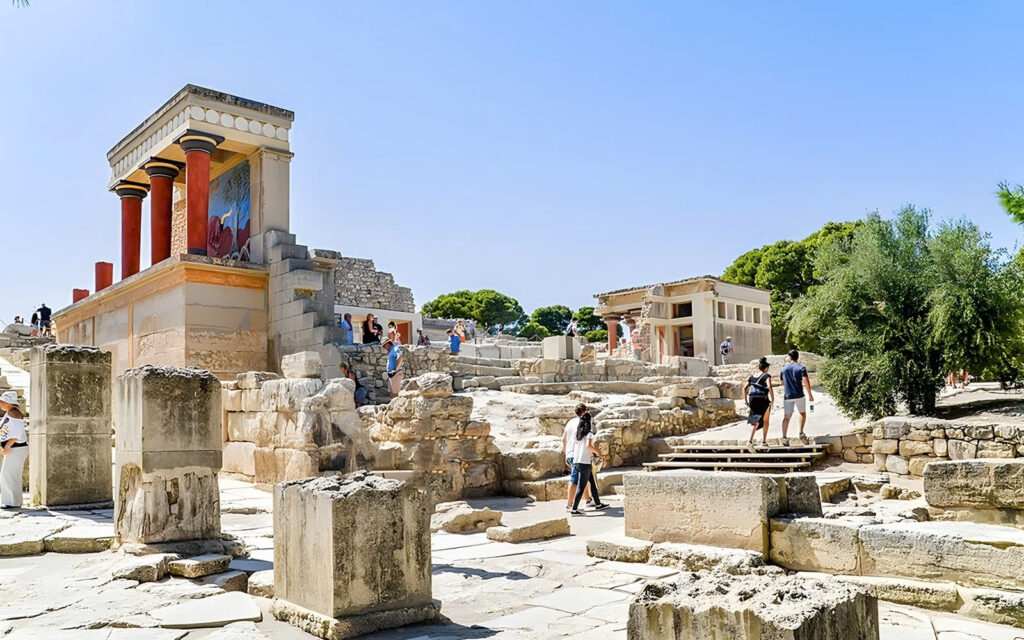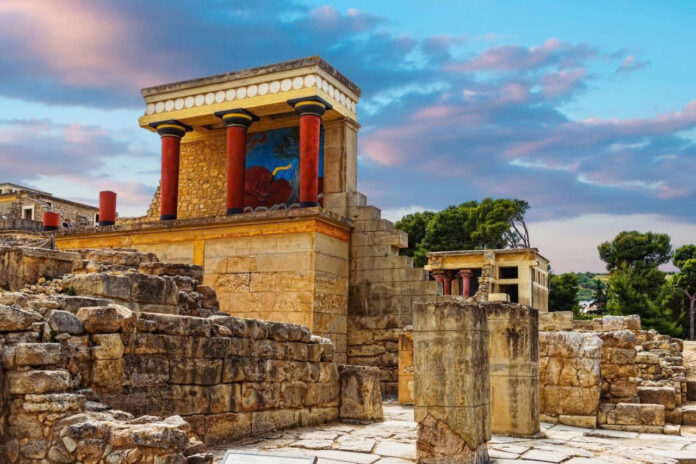A Gateway to Europe’s Forgotten Past
Hidden beneath the Mediterranean sun, just five kilometers from Heraklion’s bustling streets, lies one of archaeology’s most captivating treasures. The Palace of Knossos stands as a testament to a civilization so advanced and mysterious that it was once dismissed as mere fantasy. This remarkable Bronze Age complex, now recognized as Europe’s oldest city, offers visitors a unique window into the world of the Minoans – a people whose very name remains shrouded in mystery.

The archaeological wonder of Knossos extends far beyond its famous palace walls. The entire site encompasses an ancient metropolis that once thrived as the heart of Minoan civilization. Today, it represents Crete’s most significant archaeological discovery, drawing visitors from around the world to witness the remnants of this extraordinary culture.
The Rise and Fall of a Legendary Civilization
Cycles of Destruction and Rebirth
The story of Knossos is one of resilience and tragedy. Throughout its long history, the city experienced multiple catastrophic events that led to its destruction and subsequent reconstruction. Archaeological evidence reveals at least two major rebuilding phases, creating complex layers of history that continue to challenge researchers today.
The final chapter of Knossos came with a devastating fire that consumed the palace and surrounding areas. Following this ultimate destruction, the once-magnificent city was gradually abandoned, eventually disappearing beneath centuries of accumulated earth and vegetation. For millennia, Knossos existed only in the realm of Greek mythology, its physical reality forgotten until the late 19th century.
The Rediscovery That Changed History

In 1878, Sir Arthur Evans stumbled upon what would become one of archaeology’s most significant discoveries. When systematic excavations began in 1900, the field of archaeology was still developing its scientific methods. Evans’ ambitious reconstruction efforts, while groundbreaking for their time, have since sparked considerable debate among modern archaeologists regarding the accuracy of his interpretations and restoration techniques.
Despite the controversies surrounding his methods, Evans deserves credit for bringing this lost civilization back to light. His work provided the first glimpse into a sophisticated Bronze Age culture that had been completely forgotten by history.
Mythological Connections: Where Legend Meets Reality
The Legendary King Minos
At the heart of Knossos mythology stands King Minos, described in ancient Greek literature as Crete’s first ruler and a son of Zeus and Europa. Homer’s epic poems, the Iliad and Odyssey, feature this legendary figure, though the character would have been familiar to audiences for centuries before these works were composed. It was King Minos who inspired Evans to name the entire civilization “Minoan.”
The Labyrinth: Palace or Underground Maze?

The most enduring mystery surrounding Knossos involves the legendary Labyrinth. Greek mythology presents various interpretations of this famous maze, with some accounts suggesting the palace itself served as the labyrinth. This theory gained support from Evans, who noted how the complex network of interconnected rooms could easily confuse and trap unwary visitors.
Alternative versions of the myth describe an underground labyrinth beneath the palace. While no such structure has been discovered at Knossos, intriguing evidence at the nearby Minoan site of Gortyn suggests this possibility cannot be entirely dismissed.
The Master Craftsman and His Tragic Tale
Daedalus: Architect of Wonders
According to the most popular mythological account, King Minos commissioned the renowned inventor and architect Daedalus to design an inescapable maze. The challenge was to create a structure so ingeniously complex that anyone entering would become hopelessly lost without a guide to show them the way out.
The Price of Knowledge

Recognizing that Daedalus possessed dangerous knowledge about the labyrinth’s secrets, King Minos made a fateful decision. He imprisoned both the architect and his young son Icarus in a tall tower, believing this would prevent them from ever revealing the maze’s design to others.
The king had underestimated his prisoner’s ingenuity. Daedalus crafted wings from bird feathers and beeswax, enabling both father and son to escape their lofty prison. However, freedom came at a terrible cost. Despite his father’s warnings, young Icarus flew too close to the sun in his excitement. The intense heat melted the wax binding his artificial wings, sending him plummeting to his death in the sea below.
Video
The Terror of the Labyrinth
The Minotaur’s Domain
The labyrinth served as more than just a maze – it was also home to one of mythology’s most fearsome creatures. The Minotaur, described as a terrifying beast with the body of a man and the head of a bull, was so dangerous that even King Minos dared not let it roam free. The creature’s confinement within the labyrinth’s twisting passages kept both the monster and the kingdom safe from its rage.

Archaeological evidence from Knossos reveals the special significance of bulls in Minoan culture. Elaborate frescoes, ceremonial vessels, and architectural elements throughout the site feature bull imagery, suggesting these animals held sacred or symbolic importance. This cultural reverence for bulls provides a fascinating link between the mythological Minotaur and the actual religious practices of the people who built Knossos.
The connection between myth and reality becomes even more compelling when considering the legend of Theseus and the Minotaur, another tale that intertwines with the story of Knossos and adds another layer to the palace’s rich mythological heritage.
Visiting Knossos Today

For modern visitors, Knossos offers an unparalleled opportunity to walk through both history and legend. The site continues to reveal new secrets as archaeological work progresses, while the mythological connections provide a captivating framework for understanding this ancient civilization. Whether viewed through the lens of scientific archaeology or mythological storytelling, the Palace of Knossos remains one of the Mediterranean’s most compelling destinations.

